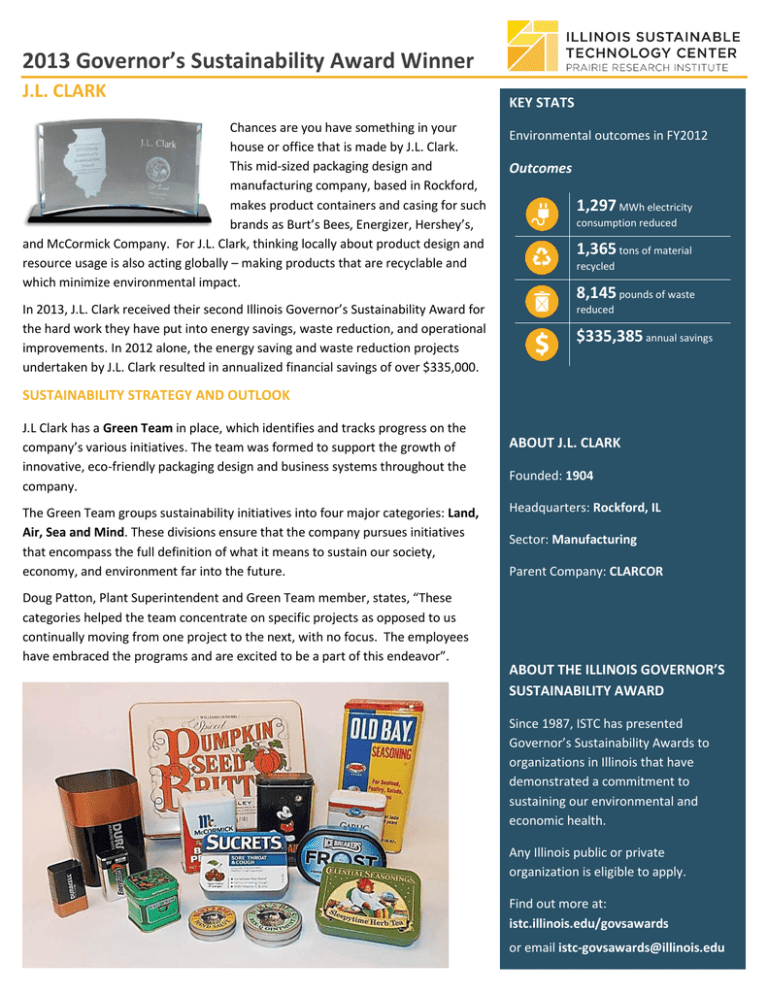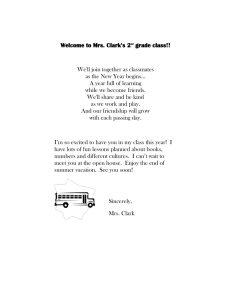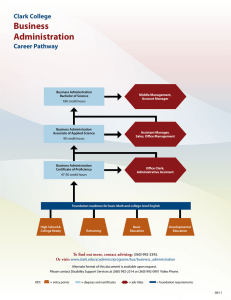J. L. Clark - Illinois Sustainable Technology Center
advertisement

2013 Governor’s Sustainability Award Winner J.L. CLARK Chances are you have something in your house or office that is made by J.L. Clark. This mid-sized packaging design and manufacturing company, based in Rockford, makes product containers and casing for such brands as Burt’s Bees, Energizer, Hershey’s, and McCormick Company. For J.L. Clark, thinking locally about product design and resource usage is also acting globally – making products that are recyclable and which minimize environmental impact. In 2013, J.L. Clark received their second Illinois Governor’s Sustainability Award for the hard work they have put into energy savings, waste reduction, and operational improvements. In 2012 alone, the energy saving and waste reduction projects undertaken by J.L. Clark resulted in annualized financial savings of over $335,000. KEY STATS Environmental outcomes in FY2012 Outcomes 1,297 MWh electricity consumption reduced 1,365 tons of material recycled 8,145 pounds of waste reduced $335,385 annual savings SUSTAINABILITY STRATEGY AND OUTLOOK J.L Clark has a Green Team in place, which identifies and tracks progress on the company’s various initiatives. The team was formed to support the growth of innovative, eco-friendly packaging design and business systems throughout the company. The Green Team groups sustainability initiatives into four major categories: Land, Air, Sea and Mind. These divisions ensure that the company pursues initiatives that encompass the full definition of what it means to sustain our society, economy, and environment far into the future. Doug Patton, Plant Superintendent and Green Team member, states, “These categories helped the team concentrate on specific projects as opposed to us continually moving from one project to the next, with no focus. The employees have embraced the programs and are excited to be a part of this endeavor”. ABOUT J.L. CLARK Founded: 1904 Headquarters: Rockford, IL Sector: Manufacturing Parent Company: CLARCOR ABOUT THE ILLINOIS GOVERNOR’S SUSTAINABILITY AWARD Since 1987, ISTC has presented Governor’s Sustainability Awards to organizations in Illinois that have demonstrated a commitment to sustaining our environmental and economic health. Any Illinois public or private organization is eligible to apply. Find out more at: istc.illinois.edu/govsawards or email istc-govsawards@illinois.edu Accomplishments and Innovations INGREDIENTS FOR SUCCESS A breakdown of strategies and technologies that help J.L. Clark increase efficiency and reduce environmental impact. Energy Use Efficient manufacturing floor layout Mold rebuild and repair Compressed air efficiency Waste Reduction Thin-wall injection mold technology Plastic scrap re-grind and reuse Plastic mold vision system Internal waste characterization effort Emissions Reduction Regenerative Thermal Oxidizer Rail shipping Employee/Community Engagement Community Projects Team CLARCOR Foundation and employee giving program Participation in a variety of Industry Groups Kishwaukee Grade School supplies donation J.L. CLARK ENERGY SAVINGS Over a quarter of J.L. Clark’s 2012 cost savings were achieved simply by improving process efficiencies. By grouping all high volume production lines in one area of the Plastics manufacturing space, they were able to eliminate the need for two sets of chillers, cooling towers, and air compressors. Rebuilding and refining injection molds and tooling also resulted in significant savings. J.L. Clark also took advantage of ComEd’s Smart Ideas rebate program, making it more affordable to replace the air compressors in their metals facility. The program reduced upfront costs by 20%. JL Clark will see a 2.5 year return-oninvestment for this initiative. WASTE REDUCTION In the Zero Waste hierarchy, reduce appears right at the top. J.L. Clark has taken this message to heart in their pursuit of Zero Waste. In 2012, the company put in a mold vision system that allows the company to correct errors more quickly and reduce the volume of scrap material. Product design also presents a major opportunity to reduce material usage and waste. J.L. Clark has pursued lightweighting of the varioius containers they manufacture. Company President Phil Baerenwald notes, “A plastic container that uses 35 percent less material requires 30 percent less energy to produce.” J.L. Clark’s quest for Zero Waste is informed by a waste characterization, conducted in 2012, which identified over 300 items that are disposed, reused, or recycled throughout the facility. This data helps J.L. Clark assess the costs and benefits of waste reduction solutions for each material type. J.L. Clark 2012 Waste Sort and Characterization Results “The employees have embraced the program and are excited to be a part of this endeavor.” Doug Patton, Plant Superintendent recycling reuse / reduce istc.illinois.edu/govsawards landfill


